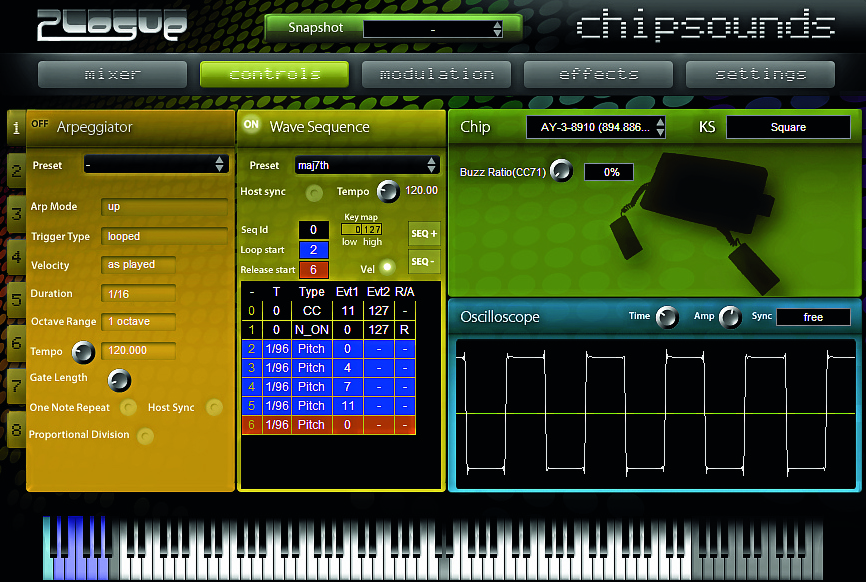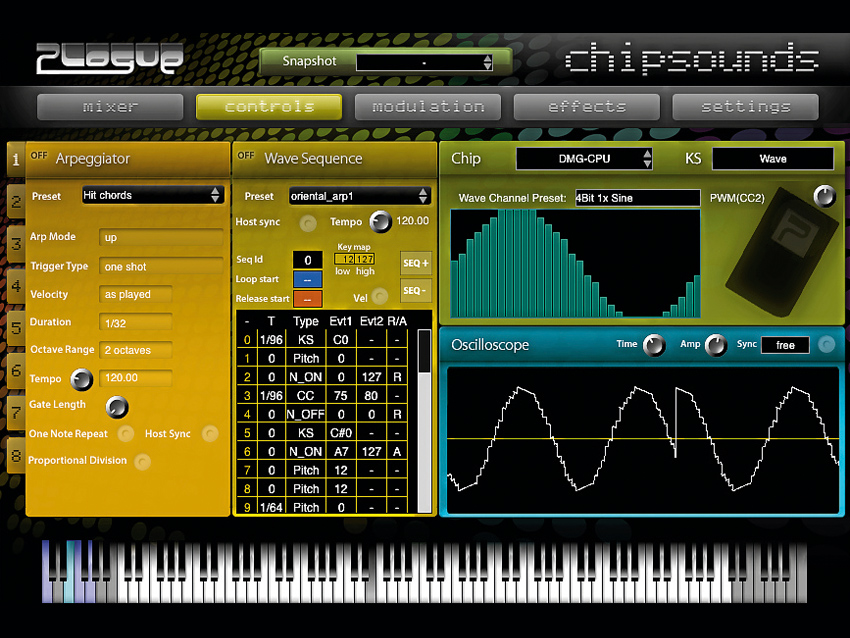MusicRadar Verdict
Chipsounds' superb emulation of nine vintage sound chips makes it a unique soft synth and a must for 8-bit-lovers.
Pros
- +
Many chips to choose from. Fantastic quality and attention to detail. Great real-time performance modes. Good value.
Cons
- -
Far too few presets. Some GUI elements are poorly executed. SID and AY emulations not 100%.
MusicRadar's got your back
There are two reasons why the sounds of outdated computers and games consoles refuse to fade into obscurity: not only do they instil great nostalgia for the days of our misspent youth, but they have a uniquely edgy and sometimes unpredictable character that smooth-running soft synths and cutting-edge beatboxes have a hard time competing with.
To get your fix of such sounds from the source would mean locating a working example of a 20-30 year-old piece of hardware and obtaining (and learning to use) some music software, or programming your own. And as for integrating the bleepin' thing with an existing setup, that's another world of pain. But with a modern Mac or PC and Plogue's Chipsounds, you can have essentially the same results after suffering a mere 30-second installation routine.
Overview
Chipsounds is a soft synth that offers a faithful recreation of nine classic chip configurations found in home computers and consoles of the '70s/'80s. The documentation carefully avoids mentioning actual brands, but you can expect to find emulations of the chips from old favourites like the Nintendo Entertainment System, Atari ST, ZX Spectrum 128, Nintendo Game Boy, Commodore 64 and VIC-20, Atari 400/800 and 2600.
There are some less well-known efforts, too, such as the SN76489 found in the ColecoVision console and BBC Micro; the P8244/ P8245 of the Magnavox Odyssey²; and the UVI 2637 that lurked inside the Arcadia 2001. And there's one final chip that comes from neither console nor computer but from Casio's VL-1 mini keyboard.
"An enormous - some would say obsessive - amount of effort has clearly gone into deciphering how these chips create their signature sounds."
An enormous - some would say obsessive - amount of effort has clearly gone into deciphering how these chips create their signature sounds. We're used to seeing this kind of attention to detail in emulations of classic synths and studio gear, but here the same ethos has been applied to mass-produced home entertainment devices.
The five-page user interface, while not ideal, is at least straightforward. The Controls page is the most important, offering an arpeggiator and wave sequencer preset-saving for both sections.
The arpeggiator offers ten playback patterns with host sync. As well as looping, it can play in one-shot mode, with or without sustain of the last note. Also cool is Proportional Division, which ensures that each arp cycle lasts the same amount of time, whether you play two notes or ten.
However, it's the wave sequencer that's vital for those crazy, rapid note flutters and crescendos that chip musicians wield so well. As the manual rightly states, it looks much like the 'instrument' or 'sample' pages found in trackers on 8-bit machines - basically, a mini-tracker that's triggered on each note. Rows are played from top to bottom, with the duration of each specified in the T column, and a row can play a note, switch waveforms, adjust the pitch or modulate any parameter.
But this is where the GUI really grinds, as not only is the visible range of the table tiny, but it's entirely mouse-driven - click the MIDI CC column, for instance, and a huge dropdown menu appears, ranging from 0 to 127. Tracker-style keyboard control would be preferable, or at least the option to increment/decrement with left/right keys.
Each chip has custom controls and a selection of timbres (eg, waveforms, noise types and chip 'tricks'), selected using keyswitches or a menu. Many chips come in several varieties, eg, PAL and NTSC types, offering European and US chip clock timings respectively, and thus slightly different tunings.
The sound engine uses a careful combination of synthesis and samples - around 95% is the former, says Plogue. As for control, many generic parameters (eg, in the Modulation page) are exposed via MIDI CC and, where appropriate, chip-specific parameters such as SID PWM are bound to CCs, too.

Sound
Which are the tastiest chips? Top of most people's wanted list is surely the SID chip of Commodore 64 fame. We found its reproduction to be remarkably accurate, buzzing away nicely from the saw waveform or tightly vibrating our speakers with its triangle output.
The waveform list includes mixed combinations alongside versions that include ring modulation. There's no dynamic ring modulation or oscillator sync, but these are promised as the SID emulation moves closer to synthesis (it's currently the most sample-based of the emulations). Controls available are filter type, cutoff and resonance, as well as PWM with LFO modulation.
Our second favourite has to be the DMG-CPU, as used by Nintendo's Game Boy. This chip creates a smoother sound using either a pulse waveform with adjustable width, or a custom waveform you can draw in yourself. If you're after a more industrial sound, then the crude, crunching tones of the POKEY integrated circuit, as used by early Atari machines, will find a place in your heart. Plenty of raw harmonics can be found in the earlier waveforms, while the wayward tuning of the '1x1' register configuration is present and correct.
"Top of most people's wanted list is surely the SID chip of Commodore 64 fame. We found its reproduction to be remarkably accurate."
Also neat are the crunchy, characterful drum kits, which use samples replayed via the emulated chips - eg, using C64 'digi' routines.
As well as the aforementioned SID, the other chip that we found to be 'not all there' is the AY-3-8910/YM2149F emulation. Unlike the real thing, you can't blend the noise channel with the pulse wave, which rules out certain possibilities of the original chip (eg, snare drum noises). There are 'envelope waves' and an Atari ST-style 'sync buzzer' sound, but the grungy basses and squawking acid tones produced by using the envelope and pulse wave together are absent.
Plogue says that such tricks should be possible in a future version of Chipsounds, once it's sussed out a way of making them accessible. This is understandable - if Chipsounds offered the kind of low-level control that's available by programming the chips directly, it would likely make the instrument impractical, especially considering its multichip nature.
Summary
Chip pedantry aside, the real issue is sound, and we found each emulation to be very true to its original. Drifting through the far-too-few presets conjures up all kinds of memories, but more importantly, these sounds are usable and immediate. Start playing a keyboard, and you'll discover a tactile dimension to these sounds that's not readily realised with a hex editor running on a 320x200-resolution screen.
Listen to what Chipsounds can do:
Computer Music magazine is the world’s best selling publication dedicated solely to making great music with your Mac or PC computer. Each issue it brings its lucky readers the best in cutting-edge tutorials, need-to-know, expert software reviews and even all the tools you actually need to make great music today, courtesy of our legendary CM Plugin Suite.
“How daring to have a long intro before he’s even singing. It’s like psychedelic Mozart”: With The Rose Of Laura Nyro, Elton John and Brandi Carlile are paying tribute to both a 'forgotten' songwriter and the lost art of the long song intro
“The verse tricks you into thinking that it’s in a certain key and has this ‘simplistic’ musical language, but then it flips”: Charli XCX’s Brat collaborator Jon Shave on how they created Sympathy Is A Knife
“It shows enough promise to become the controller to rule them all”: Melbourne Instruments Roto-Control review











